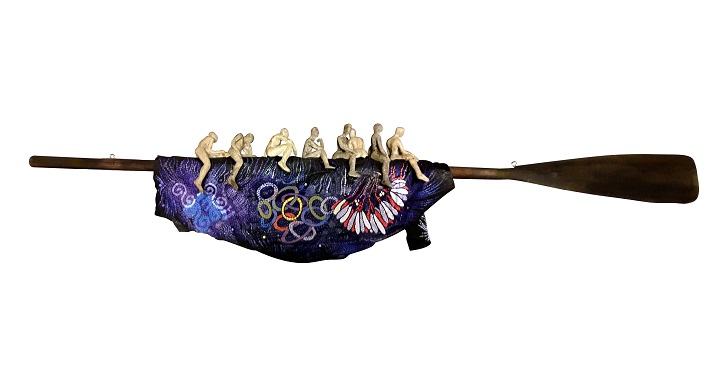Contemporary African Art Initiative brings new acquisitions and collaborations to the Chazen Museum of Art
Straus Family Foundation gift leads to 36 new works added to the permanent collection
The Contemporary African Art Initiative (CAAI) is a multi-year project that expanded the Chazen Museum of Art’s holdings of contemporary African art. The CAAI was funded by a five-year gift from the Straus Family Foundation. Using funds from the gift, curators at the Chazen purchased works created by contemporary African artists.

Péju Alatise, Bluer on the other side (The problem with immigration), Oar #8, 2020.26.2
“The CAAI is an incredibly important and relevant project for our museum and our community,” said Amy Gilman, director of the Chazen. “It adds to the global perspectives featured in our permanent collection and builds on UW–Madison’s connections to Africa through research and collaborations. We are grateful to the Straus Family Foundation for supporting this dynamic effort.”
University of Wisconsin professors Scott Straus and Sara Guyer approached Director Amy Gilman with the idea for the initiative in 2018. The Chazen, a leading university art museum nested within a large research institution with deep and collaborative connections to Africa, is well positioned to host an initiative that both expands the collection and builds global partnerships. The CAAI seeks to support contemporary African artists and develop collaborative relationships with organizations in Africa, ensuring that the artwork selected is available for viewing, study and enjoyment by a wide swath of the public at the University, in the community and globally.
The initiative builds on a small selection of contemporary African artworks collected by the Chazen since the late 1990s, including two works from the internationally acclaimed El Anatsui. “Diversifying our permanent collections and better representing the complex and intersectional world in which we live is one of the most pressing issues facing our museum,” said Gilman. “This initiative is one way we can impact the collection immediately, and set the stage for long term acquisitions, partnerships and collaborations that can only be imagined today.”
“We are thrilled to partner with the Chazen on this initiative,” said Straus. “UW–Madison has long-standing excellence in African studies and partnerships on the continent. We find extraordinary creativity, energy, beauty and vision in contemporary African art. We are excited to be part of an initiative that brings some of that art to Madison and that simultaneously supports the work of African artists. We hope that this initiative will provide a foundation for research, teaching and collaboration for years to come.”
Guyer adds that “this initiative also is designed to help reshape the processes by which U.S. museums like the Chazen collect work from Africa and to initiate collaborations with artists and institutions on the continent.”
To date, through the Contemporary African Art Initiative, the Chazen Museum of Art has purchased 36 works from 19 artists representing 12 countries in Africa. The first group of objects were chosen because of their individual power and interest, and because their diversity of approach and media reflects trends in contemporary African art. In addition, they were selected with the intention of developing relationships with these artists, many of whom are involved with institution-building in their home communities. “We see this as the beginning of our relationship with both these artists and the next generation of artists they are fostering through their community engagement,” said Katherine Alcauskas, chief curator of the Chazen.
Highlights of the acquisitions include Exodus by Cameroonian artist Barthélémy Toguo, a leader in the field who also created Bandjoun Station, a foundation that hosts researchers and artists-in-residence and helps them develop project proposals alongside their local communities. “Exodus” is drawn from a body of work that Toguo began in 2008 for an exhibition at the National Museum of Immigration in Paris. The work considers the migrant and refugee crises, and consists of a bike-drawn wagon filled with bags made from African fabrics and polypropylene. Exodus is currently on view at the Chazen.
Another work, Mary Sibande’s Sower in the Field, is a rare large-scale bronze created by the South African artist best known for her sculptures and works on paper that document performances. In these works, Sibande places female domestic workers in roles of power denied to them under apartheid in South Africa. Given the current cultural discussions around the purpose, intent and effect of monuments in America, this work—a life-size sculpture of a black woman intended to be shown at ground level—will engage students and visitors in conversations around representation. The sculpture was cast at a foundry in South Africa, supporting local enterprise and industry.
Born in Lille to a French Ivorian family, photographer François-Xavier Gbré trained in commercial photography in Italy and France before relocating in 2010 to Bamako, Mali, and later Abidjan, Côte d’Ivoire. He often turns his camera to modernist construction in these areas of Africa. The Chazen purchased two of his works, Piscine #1, Université Félix-Houphouët-Boigny, Riviera, Cocody, Abidjan and Station CIDP #2, Ségou, Mali.
Other works acquired in the first group include sculpture by Moataz Nasr (Egypt), multimedia work by Collin Sekajugo (Uganda, Rwanda), photography by Léonard Pongo (Democratic Republic of the Congo), photography by Lebohang Kganye (South Africa) and sculpture by Péju Alatise (Nigeria).
An additional work, by Senegalese painter Omar Ba, has also been acquired utilizing other museum acquisition funds, with the intention of being complementary to the CAAI.